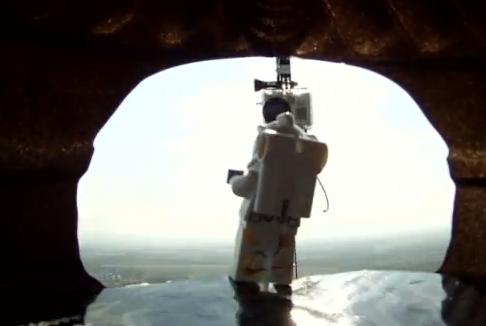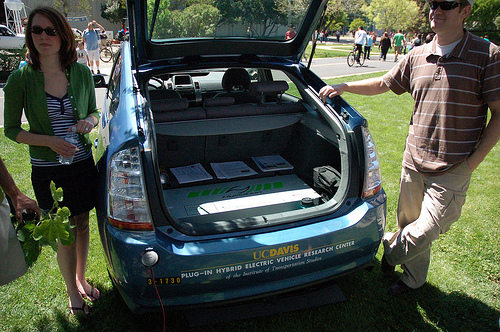During tonight’s second presidential debate, you will hear mention of A123. There’s no question of that; Mitt Romney has already started working it into his regular routine. In keeping with our motto (“Post things on the web”), Gristmill is here to explain what, exactly, an “A123” is.

r_nechesShowing off A123 batteries at UC Davis.
A123 Systems is (was?) a manufacturer of “advanced batteries,” energy storage systems primarily used in electric cars. Today, after at least one high-profile attempt to raise revenue, the company filed for bankruptcy. According to the Department of Energy, Milwaukee-based Johnson Controls will purchase two of A123’s manufacturing facilities and fund the company during its bankruptcy transition.
Why does the Department of Energy care? Because A123 was one of the department’s investments in bolstering the domestic advanced-battery manufacturing sector.
Four years ago, virtually all advanced vehicle batteries were built overseas, and it looked like the United States might miss out on this enormously important, rapidly expanding market.
That is why, starting in the previous administration, the Department of Energy has made a number of investments to support these innovative technologies. Under this Administration, the Department of Energy, with strong bipartisan support, awarded $2 billion in grants to 29 companies to build or retool 45 manufacturing facilities spread across 20 states to build advanced batteries, engines, drive trains and other key components for electric vehicles. More than 30 of these plants are already in operation, employing thousands of American workers, and our grants were matched dollar for dollar (or more) by private investments.
A123 received a $6 million grant under George W. Bush and a $249.1 million grant under Obama from the 2009 stimulus package. The company used $132 million of that money. And, therefore, according to Mitt Romney, A123 is an example of how Obama wastes money on green projects.
“A123’s bankruptcy is yet another failure for the President’s disastrous strategy of gambling away billions of taxpayer dollars on a strategy of government-led growth that simply does not work,” said Andrea Saul, a spokeswoman for Mitt Romney.
As the DOE pointed out, A123 also received support from Republicans like Rep. Dale Kildee (R-Mich.), putting the company in the same boat as the Wisconsin Energy Conservation Corporation, an energy-efficiency organization that got $20 million from the stimulus thanks to Rep. Paul Ryan.
Other advanced-battery companies that were targets of government investment are doing much better. From the DOE:
- This summer, Rockwood Lithium announced the opening of their expanded manufacturing facility in Kings Mountain, North Carolina. They have hired 75 workers and plan to hire even more as their business continues to grow.
- The Delphi plant in Kokomo, Indiana, which had been hit by devastating layoffs during the great recession, is growing again as workers produce components for hybrid electric vehicles.
- Earlier this year, EnerG2 celebrated the opening of its new electric vehicle battery components manufacturing facility in Albany, Oregon.
- Envia Systems of Newark, California, building off technology invented at Argonne National Laboratory and developed with the help of a decade of sustained support by the Department of Energy, recently achieved a breakthrough that will triple the energy density of their batteries while cutting the cost of batteries in half.
The Obama administration should be able to fend off Romney’s standard bogus attack line that these investments went to the president’s cronies. After all, A123 first got money under Bush (just like Solyndra did). And if it were run by Obama cronies, they probably would have waited until after a critical debate to declare bankruptcy.




